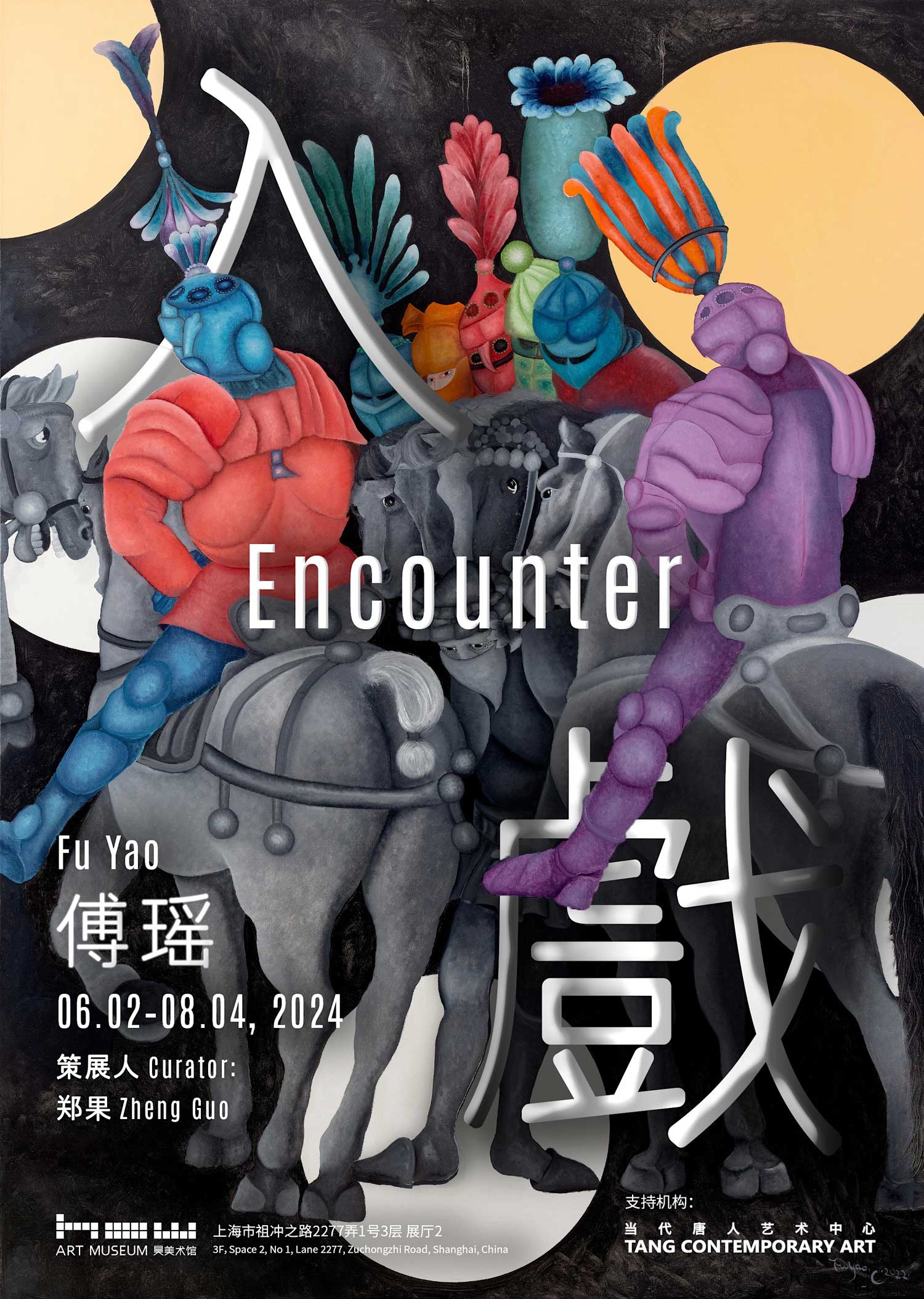展期 Period:
2024.6.2—2024.8.4
艺术家 Artist:
策展人 Curator:
支持 Support:
当代唐人艺术中心 Tang Contemporary Art
地点 Venue:
展览前言 Foreword:
踩着月亮或隐去在夜色里的马匹,载着交错于黑白彩色之中的骑士,他们互为主角碰撞出一幕神秘象征主义的画面。他们可以是某次历史事件中真实人物的对照,也可以是某部荒诞剧里游荡在人间的灵魂。艺术家傅瑶所创造的空间,不仅是画面内与画面外的单线维度。她留下暗流涌动的缝隙,而观者似乎可以从缝隙的任意角度中闯入她构建的剧目里。
彼得·布鲁克曾在其著作《空的空间》里提到“一个人在别人的注视下走过这个空间,这就足以构成一幕戏剧”。戏剧性的关键并不依赖故事情节,而在于事件的发生。傅瑶通过魔幻且荒诞不经的画面,让事件交织着不同文化、背景的人物与故事发生于画布上。因为她深知,只有发生才有可能入戏。
傅瑶全新个展通过呈现其三十件作品,将艺术家的创作脉络与精神世界以非垂直的方式邀请观者一同“入戏”。在“剧本”系列中,傅瑶用几何舞台式的画面消解了观者对于经典故事的既定印象,通过再叙事的手法突破大众的理解结构。而再叙事中暧昧疏离的处理方式,削弱了传统寓言故事里的说教意味,使其更生动自由,同时给作品增添了某种如同命运一般流动而不可控的宿命感。
尽管艺术家描绘的场景天马行空,但无论是“剧本”系列,还是全新的“入戏”系列,画面中的人物形象,都被隐去了真实的面孔。脸孔是人类的第一层人格面具,有着隐藏自我与本质的特性,是个人适应抑或他认为所采用的方式对付世界体系。反观傅瑶画作里戴着各式面具、画着小丑妆的人物,在模糊隐去了自我的同时,又在另一层面上展露出更贴近真实与本质的样貌。艺术家通过颇具象征意味的“戏服”、场景甚至动物,诙谐而不失优雅地刻画出人的欲望与动物性,从而让观众在刻意遗留的五官里反观、寻找自我。
让·保罗·萨特通过九个剧本让“情景剧”成为戏剧中的重要类型,同时对后来的“荒诞派戏剧”有着深远地影响。如果说哲学家是借台词之口输入其哲学理念,那么画家则通过画作细节来表达思想。在傅瑶的作品《不再复仇的哈姆雷特》系列中,她将广为流传的西方戏剧重新定义,用介于叙事者与参与者之间的角度描绘了三张圆形分镜。它们独立成章又互为故事的补充。傅瑶在具象中加入抽象的绘画手法,也让其背后的深意虚实共存。无论哲学、戏剧、还是艺术,其终极目标在于“人”。艺术家傅瑶所构建的超越时间、空间的剧场画面,让所有人都走入其中,参与其中,任由各种可能性同时发生。
文 / 郑果
Horses stepping on the moon or hidden in the night, carrying knights interspersed in black and white colours, they are the protagonists of each other colliding in a scene of mystical symbolism. They can be a counterpoint to a real person in a historical event or a wandering soul in a dystopian play. The space created by artist Fu Yao is not only the single-line dimension between inside and outside the frame. She leaves behind gaps with dark currents, and the audience seems to be able to slide through her constructed repertoire from any angle of the gaps.
Peter Brook has mentioned in his book The Empty Space that “the fact that one person walks through the space while others watch is enough to constitute a scene of theatre”. The key to drama does not depend on the storyline, but on the occurrence of the event.Through magical and absurd images, Fu Yao allows events intertwined with characters and stories from different cultures and backgrounds to take place on the canvas. Because she knows that the only way to get into the show is to make it happen.
By presenting 30 works, Fu Yao’s new solo exhibition invites audiences to Encounter in a non-vertical way through the artist’s creative vein and spiritual world. In the Scenario series, Fu Yao uses geometric stage-like images to dissolve the viewer’s preconceived notions of classic stories, and breaks through the structure of the public’s understanding through the technique of re-narrative. The ambiguous and detached approach of the re-narrative weakens the didactic meaning of the traditional fables, making them more vivid and free, while adding a sense of destiny to the work, which is as fluid and uncontrollable as fate.
Although the artist’s scenarios are wildly imaginative, in both the Scenario series and the new Encounter series, the characters are depicted with their real faces hidden from view. The face is the first mask of the human personality, with the property of concealing the self and the essence of the individual, the way he adapts or he thinks he has to deal with the world system. On the other hand, the characters in Fu Yao’s paintings wearing various masks and clown make-up, while blurring and concealing their own selves, reveal on another level an appearance closer to the truth and essence. Through the symbolic “costumes”, scenes and even animals, the artist wittily and elegantly portrays human desires and animalistic nature, allowing the audience to look back and search for their innerself in the deliberately leftover features.
Jean-Paul Sartre, through his nine plays, made the “sitcom” an important genre of theatre and had a profound influence on the later “theatre of the absurd”. If philosophers input their philosophical ideas through the mouths of their lines, painters express their thoughts through the details of their paintings. In Fu Yao's series Hamlet No More Revenge, she redefines the popular Western theatre by depicting three circular subplots from a perspective between the narrator and the participants. They stand alone and complement each other's stories. Fu Yao's abstract painting technique is added to the figurative, which also allows the underlying meaning to coexist with the real and the imaginary. Whether it is philosophy, theatre or art, the ultimate goal lies in “human beings”. The theatre picture constructed by artist Fu Yao transcends time and space, allowing everyone to walk in and participate, allowing all possibilities to happen at the same time.

